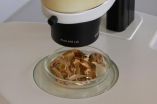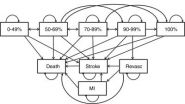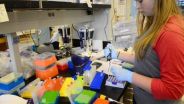(Press-News.org) This news release is available in French.
According to a study conducted by pediatricians and researchers at Sainte-Justine University Hospital Research Center (Sainte-Justine) and Université de Montréal published online in the prestigious medical journal Nature Medicine on September 14, 2014, the activation of a receptor that migrates to the nucleus of nerve cells in the retina promotes the growth of blood vessels. The finding opens the possibility of developing new, more selective drugs to control the abnormal growth of blood vessels and prevent blindness including retinopathy of prematurity, a disorder that may result in retinal detachment due to abnormal blood vessel growth in the retina of the eye.
"This study shows that a single receptor may play various roles depending on whether its site of action is in the nucleus or on the cell membrane," states Dr. Jean-Sébastien Joyal, MD, PhD, a pediatric intensivist at the Sainte-Justine UHC and an assistant professor at the Université de Montréal. The groundbreaking discovery has significant clinical implications, since many drugs act on this family of receptors irrespective of their site of action in the cell. "Our results are extremely encouraging. They indicate that drugs formulated to target this nuclear receptor may one day prevent retinopathy in premature babies," continued Dr. Sylvain Chemtob, a neonatologist at Sainte-Justine and a full professor in Pediatrics, Ophthalmology and Pharmacology at the Université de Montréal.
Abnormal proliferation of blood vessels may lead to a number of disorders. Therefore, the finding may offer therapeutic potential for other conditions, particularly proliferative diabetic retinopathy and cancer. This potential still needs to be explored.
INFORMATION:
About the study
The study entitled "Subcellular localization of coagulation factor II receptor-like 1 in neurons governs angiogenesis" was published in Nature Medicine on September 14, 2014. It was funded by the Canadian Institutes of Health Research, March of Dimes, Burroughs Wellcome Fund, Foundation Fighting Blindness and the Fonds de recherche du Québec – Santé. The researchers Gregor Andelfinger and Christian Beauséjour from Sainte-Justine and the Université de Montréal also contributed toward the development of the study.
About the researchers
Dr. Sylvain Chemtob, MD, PhD, FRCPC, FCAHS is a full professor in the Departments of Pediatrics, Ophthalmology and Pharmacology at the University of Montreal, and holds a Canada Research Chair (vision science) and the Leopoldine Wolfe Chair in translational research in age-related macular degeneration. He is also a researcher in the Fetomaternal and Neonatal Pathologies research axis at Sainte-Justine University Hospital Research Center
Dr. Jean-Sébastien Joyal, MD, PhD, is a pediatric intensivist at the Sainte-Justine UHC and an assistant professor in the Department of Pediatrics at Université de Montréal. He is also a researcher in the Metabolic Health axis at Sainte-Justine University Hospital Research Center
A new therapeutic target may prevent blindness in premature babies at risk of retinopathy
A receptor located in the nucleus of retinal neurons promotes vascular growth
2014-09-16
ELSE PRESS RELEASES FROM THIS DATE:
What's for dinner? Rapidly identifying undescribed species in a commercial fungi packet
2014-09-16
For lovers of wild foods, autumn harks a season of bounty. Fungi of dizzying variety erupt from wood and soil, luring intrepid collectors to woodlands in search of elusive but delectable wild mushrooms. Part of their appeal lies in the allure of the treasure hunt, and their mysterious not-quite-meat, not-quite-vegetable qualities that belie an almost otherworldly existence. But are the mushrooms which you are eating known to science?
The Fungi Kingdom is enormously diverse yet vastly underdocumented – although some estimates range up to 10 million species, only about ...
Imaging identifies asymptomatic people at risk for stroke
2014-09-16
OAK BROOK, Ill. – Imaging can be a cost-effective way to identify people at risk for stroke who might benefit from aggressive intervention, according to a new modeling study published online in the journal Radiology.
The study looked at people with asymptomatic carotid artery stenosis, a narrowing of the major blood vessels supplying blood to the head due to atherosclerosis, or plaque buildup. Carotid artery stenosis is the primary cause of up to 20 percent of ischemic strokes, which result from an obstruction within a blood vessel and make up 85 percent of all strokes. ...
Researchers debunk myth about Parkinson's disease
2014-09-16
Using advanced computer models, neuroscience researchers at the University of Copenhagen have gained new knowledge about the complex processes that cause Parkinson's disease. The findings have recently been published in the prestigious Journal of Neuroscience.
The defining symptoms of Parkinson's disease are slow movements, muscular stiffness and shaking. There is currently no cure for the condition, so it is essential to conduct innovative research with the potential to shed some light on this terrible disruption to the central nervous system. Using advanced computer ...
Dental and nutrition experts call for radical rethink on free sugars intake
2014-09-16
Sugars in the diet should make up no more than 3% of total energy intake to reduce the significant financial and social burdens of tooth decay, finds new research from UCL (University College London) and the London School of Hygiene & Tropical Medicine.
The study, published in the open-access journal BMC Public Health, analysed the effect of sugars on dental caries, also known as tooth decay. They show that sugars are the only cause of tooth decay in children and adults.
Free sugars are defined by the World Health Organisation Nutrition Guidance Adivisory Group as follows: ...
Collaboration drives achievement in protein structure research
2014-09-15
When this week's print issue of the journal Science comes out, a collective cheer will go up from New Mexico, Montana and even the Netherlands, thanks to the type of collaborative effort that is more and more the norm in these connected times. Yes, the research was brilliant, and if we're lucky, it will produce innovations in biology, medicine, biotechnology and agriculture. It could save lives, and it happened because this scientist talked with that one, that one knew another one, and brilliant minds overcame geographic distance to advance human understanding.
"It is ...
Certain form of baldness at age 45 linked to higher risk of aggressive prostate cancer
2014-09-15
A new, large cohort analysis from the prospective Prostate, Lung, Colorectal and Ovarian (PLCO) Cancer Screening Trial, indicates that men who had moderate baldness affecting both the front and the crown of their head at age 45 were at a 40% increased risk of developing aggressive prostate cancer (usually indicates a faster growing tumor resulting in poorer prognosis relative to non-aggressive prostate cancer) later in life, compared to men with no baldness. There was no significant link between other patterns of baldness and prostate cancer risk. The study, published September ...
Researcher develops and proves effectiveness of new drug for spinal muscular atrophy
2014-09-15
COLUMBIA, Mo. – According to recent studies, approximately one out of every 40 individuals in the United States is a carrier of the gene responsible for spinal muscular atrophy (SMA), a neurodegenerative disease that causes muscles to weaken over time. Now, researchers at the University of Missouri have made a recent breakthrough with the development of a new compound found to be highly effective in animal models of the disease. In April, a patent was filed for the compound for use in SMA.
"The strategy our lab is using to fight SMA is to 'repress the repressor,'" said ...
EEG study findings reveal how fear is processed in the brain
2014-09-15
DALLAS, TX – September 12, 2014 - An estimated 8% of Americans will suffer from post traumatic stress disorder (PTSD) at some point during their lifetime. Brought on by an overwhelming or stressful event or events, PTSD is the result of altered chemistry and physiology of the brain. Understanding how threat is processed in a normal brain versus one altered by PTSD is essential to developing effective interventions.
New research from the Center for BrainHealth at The University of Texas at Dallas published online today in Brain and Cognition illustrates how fear arises ...
Smithsonian scientists discover tropical tree microbiome in Panama
2014-09-15
Human skin and gut microbes influence processes from digestion to disease resistance. Despite the fact that tropical forests are the most biodiverse terrestrial ecosystems on the planet, more is known about belly-button bacteria than bacteria on trees in the tropics. Smithsonian scientists and colleagues working on Panama's Barro Colorado Island discovered that small leaf samples from a single tree were home to more than 400 different kinds of bacteria. The combined sample from 57 tree species contained more than 7,000 different kinds.
Bacteria in tropical forests may ...
Scientists discover RNA modifications in some unexpected places
2014-09-15
CAMBRIDGE, Mass. (September 15, 2014) – The so-called central dogma of molecular biology—that DNA makes RNA which makes protein—has long provided a simplified explanation for how genetic information is deciphered and translated in living organisms.
In reality, of course, the process is vastly more complicated than the schema first articulated nearly 60 years ago by Nobel Laureate Francis Crick, co-discoverer of the DNA's double-helix structure. For one, there are multiple types of RNA, three of which—messenger RNA (mRNA), transfer RNA (tRNA), and ribosomal RNA (rRNA)—are ...
LAST 30 PRESS RELEASES:
Study highlights increased risk of second cancers among breast cancer survivors
International DNA Day launch for Hong Kong’s Moonshot for Biology
New scientific resources map food components to improve human and environmental health
Mass General Brigham research identifies pitfalls and opportunities for generative artificial intelligence in patient messaging systems
Opioids during pregnancy not linked to substantially increased risk of psychiatric disorders in children
Universities and schools urged to ban alcohol industry-backed health advice
From Uber ratings to credit scores: What’s lost in a society that counts and sorts everything?
Political ‘color’ affects pollution control spending in the US
Managing meandering waterways in a changing world
Expert sounds alarm as mosquito-borne diseases becoming a global phenomenon in a warmer more populated world
Climate change is multiplying the threat caused by antimicrobial resistance
UK/German study - COVID-19 vaccine effectiveness and fewer common side-effects most important factors in whether adults choose to get vaccinated
New ultraviolet light air disinfection technology could help protect against healthcare infections and even the next pandemic
Major genetic meta-analysis reveals how antibiotic resistance in babies varies according to mode of birth, prematurity, and where they live
Q&A: How TikTok’s ‘black box’ algorithm and design shape user behavior
American Academy of Arts and Sciences elects three NYU faculty as 2024 fellows
A closed-loop drug-delivery system could improve chemotherapy
MIT scientists tune the entanglement structure in an array of qubits
Geologists discover rocks with the oldest evidence yet of Earth’s magnetic field
It’s easier now to treat opioid addiction with medication -- but use has changed little
Researchers publish final results of key clinical trial for gene therapy for sickle cell disease
Identifying proteins causally related to COVID-19, healthspan and lifespan
New study reveals how AI can enhance flexibility, efficiency for customer service centers
UT School of Natural Resources team receives grant to remove ‘forever chemicals’ from water
Sweet potato quality analysis is enhanced with hyperspectral imaging and AI
Use of acid reflux drugs linked to higher risk of migraine
For immigrants to Canada, risk of MS increases with proportion of life spent there
Targeted use of enfortumab vedotin for the treatment of advanced urothelial carcinoma
A university lecture, with a dash of jumping jacks
How light can vaporize water without the need for heat
[Press-News.org] A new therapeutic target may prevent blindness in premature babies at risk of retinopathyA receptor located in the nucleus of retinal neurons promotes vascular growth




